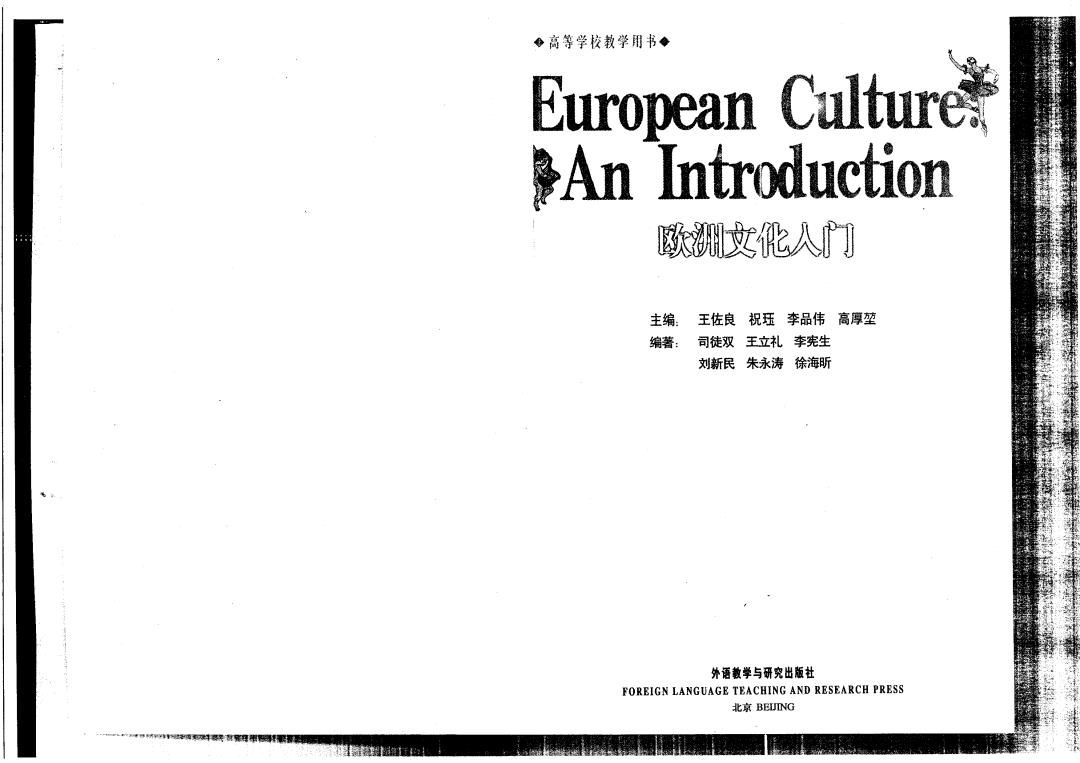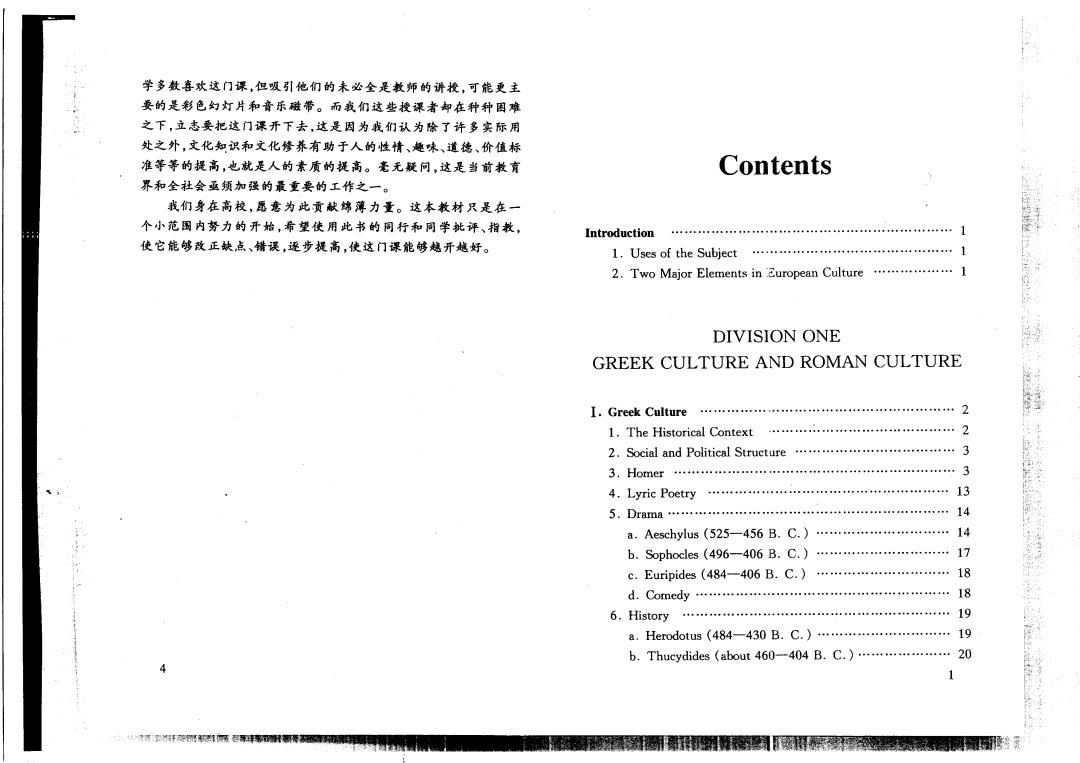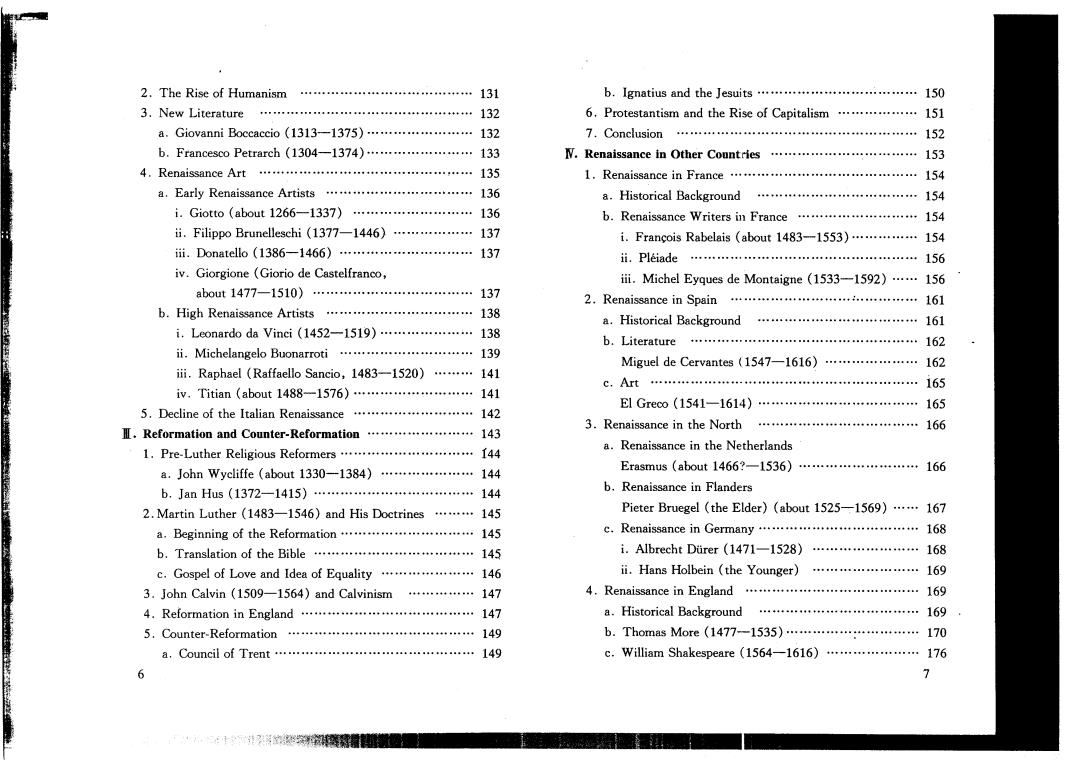
。高等学校教学用书◆ European Culture 是An Introduction 欧洲文化人门 主编:王佐良祝珏李品伟高厚堃 编著:司徒双王立礼李宪生 刘新民朱永涛徐海昕 外酒教学与研究出版社 FOREIGN LANGUAGE TEACHING AND RESEARCH PRESS 北京BENG

学多数春欢这门课,但吸引他们的未必全是教师的讲授,可能更主 要的是彩色幻灯片和音乐磁带。而我们这些授课者却在种种因难 之下,立志要把这门课开下去,这是因为我们认为徐了许多实际用 处之外,文化知识和文化修养有助于人的性情、趣味、道德、价值标 准等等的提高,也就是人的素质的提高。毫无疑问,这是当前教育 Contents 界和全社会亚须加强的最重要的工作之一。 我们身在高校,愿意为此贡献锦薄力量。这本教材只是在一 个小范国内努力的开始,希望使用此书的同行和同学就评、指教, ntroduction…1 使它能够改正缺点、错误,逐步提高,使这门课能够越开越好。 1.Uses of the Subject............................... 2.Two Major Elements in European Culture ............. 1 DIVISION ONE GREEK CULTURE AND ROMAN CULTURE I.Greek Culture…2 1.The Historical Context................2 2.Social and Political Structure......3 3.Homer… 3 4.Lyric Poetry… 3 5.Drama……… 14 a.Aeschylus(525-456B.C.)…14 b.Sophocles (496-406 B.C.)................ 1) c.Euripides(484-406B.C.)……1 8 d.Comedy…l8 6.History…19 a.Herodotus(484-430B.C.)… 19 b.Thucydides(about460-404B.C.)…20 山深家不平那1师+事科新餐沉

7.Philosophy and Science..22 4.Architecture,Painting and Sculpture......................47 23 a.Architecture…a…47 b。Pat0*……+*t4…444 26 i.The Pantheon............................... 47 C,Aristotle**+…………………4 27 i.Pont du Gard…… 48 d.Contending Schools of Thought ............................29 ii.The Colo8seum……48 e,Science……31 b.Painting...... 48 8.Art,Arehitecture,Sculpture and Pottery......32 c.Sculpture……48 a,Art……32 i.Constantine the Great……48 b.Architecture…32 ii.Spoils from the Temple in Jerusalem (81 A.D.) C.Sculpture… 33 …48 i.Discus Thre0ter… 33 it.She-wolf…49 ii.Venus de Mil0…34 Questi0 ns for Revision……49 iii.Laocoon group about 125 B.C....................34 d.Pottery…34 9.Impact…35 DIVISION TWO a.Spirit of Innovation…… 35 THE BIBLE AND CHRISTIANITY b.Supreme Achievement........................... c.Lasting Effect………36 Question for Revision.................36 I.General Introduction...........51 夏.Roman Culture…37 I.The old Testament.............52 1.Romans and Greeks..........37 l.The Pentateuch……52 2.Roman History… a.The Fall of Man…53 3.Latin Literature........39 b.Noah's Ark …56 a.Pr08e……40 c.Ten Commandments.......................60 i.Marcus Tullius Cicero (106-43 B.C.)......40 2.The Historical Books................62 i.Julius3Caes8r(102/100?-44B.C.)…42 3.The Poetical Books......63 b.P0etry…43 a.Book of Job 63 i.Lucretius (about 93-50 B.C.).....................43 b.Book of Psalms................ 64 i.Virgil(70-19B.C.)…44 C.Proverb…66 2 3

d.Ecclesiastes…68 2.The Church…g5 e,Song of Solomon… 68 a.The Organization of Church …95 4.The Prophets…70 b.Church Fathers and Early Monasticism ..................96 8,Am0844+…4+………*……44 70 c.The Power and Influence of the Catholic Church .98 b.Jeremiah (about 650-570 B.C.).....................71 3.The Crusades…99 c.The Book of Daniel……72 里.Learning and Science…l01 Rise of christianity...... 73 1.Charlemagne and Carolirgian Renaissance ..........101 1.The Life of Jesus 74 2.Alfred the Great and Wessex Centre of Learning... 102 2.The Spread of Christianity 75 3.S.Thomas Aquinas and Scholasticism……f 102 N.The New Testament......77 4.Roger Bacon and Experimental Science.................... 103 1,The Birth of Jesus… 78 N.Literature.. 105 2.Jesus Is Tempted by the Devil............................... 79 1.National Epics… 105 3.The Sermon on the Mount.......................79 a.Beowulf(700-750A.D.).105 4.The Last Supper …81 b.Song of Roland (about the 12th century A.D.)111 5.The Crucifixion…… 83 2.Dante Alighieri and The Divine Comedy.......118 V.Translations of the Bible.....86 3.Geoffrey Chaucer and The Canterbury Tales 123 Questions for Revision 89 V.Art and Architecture 44…126 1.Romanes3que…126 2.Gothic............. 127 DIVISION THREE Questi0n3 for Revision…… 127 THE MIDDLE AGES I.General Introduction.91 DIVISION FOUR I.Manor and Church…92 RENAISSANCE AND REFORMATION 1.Feudalism++4+…+…… 92 a.Growth of Feudalism........................... 92 I.General Introduction 129 b.The Manor 93 I.Renaissance in Italy................... 130 c.Knighthood and Code of Chivalry……,94 1.Historical Background……130 4 5 行家

2.The Rise of Humanism...................................131 b.Ignatius and the Jesuits...................150 3.New Literature................132 6.Protestantism and the Rise of Capitalism ................ 151 a.Giovanni Boccaccio (1313-1375)........................132 7.C0 nclusion…152 b.Francesco Petrarch (1304-1374).......................133 N.Renaissance in Other Countries.................. 153 4.Renaissance Art+*……*+…………1 135 1.Renaissance in France........................................... 154 a.Early Renaissance Artists................................136 a.Historical Background.............................154 i.Giotto (about 1266-1337).........................136 b.Renaissance Writers in France..........................154 ii.Filippo Brunelleschi (1377-1446).................137 i.Francois Rabelais (about 1483-1553)...............154 i.Donatello(1386-1466)…137 i.Pleiade…… 156 iv.Giorgione (Giorio de Castelfranco, iii.Michel Eyques de Montaigne (1533-1592)......156 about1477-1510)…137 2.Renaissance in Spain......... 161 b.High Renaissance Artists............................138 a.Historical Background......................... 161 i.Leonardo da Vinci (1452-1519).....................138 b.Literature………l62 ii.Michelangelo Buonarroti..............139 Miguel de Cervantes (1547-1616).................162 iii.Raphael (Raffaello Sancio,1483-1520)........141 C.Art……165 iw,Titian(about1488-1576)……141 El Gre00(1541—1614)…+…165 5.Decline of the Italian Renaissance...................142 亚.Reformation and Counter-Reformation…l43 3.Renaissance in the North................166 a.Renaissance in the Netherlands 1.Pre-Luther Religious Reformers.............................144 a.John Wycliffe (about 1330-1384)...............144 Erasmus (about 1466?-1536)...........................166 b.Jan Hus(1372-1415)……144 b.Renaissance in Flanders 2.Martin Luther (1483-1546)and His Doctrines.....145 Pieter Bruegel (the Elder)(about 1525-1569).....167 a.Beginning of the Reformation.........................145 c.Renaissance in Germany.................................168 b.Translation of the Bible...........................145 i.Albrecht Durer (1471-1528).................168 c.Gospel of Love and Idea of Equality..........146 i.Hans Holbein(the Younger)…l69 3.John Calvin (1509-1564)and Calvinism..........147 4.Renaissance in England.........................169 4.Reformation in England................147 a.Historical Background..................169 5.Counter-Reformation.......... 149 b.Thomas More(1477-1535)…:…170 a.Council of Trent................................... 149 c.William Shakespeare (1564-1616)....................176 6 7